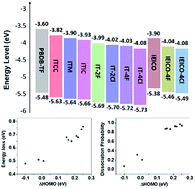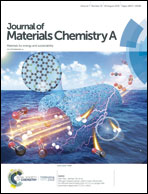Effects of energy-level offset between a donor and acceptor on the photovoltaic performance of non-fullerene organic solar cells†
Abstract
Minimizing the energy-level offset between a donor and acceptor in order to reduce energy loss (Eloss) is a hot topic in the field of organic solar cells (OSCs). However, for non-fullerene OSCs, the discussion concerning the relationship between energy-level offset and device performance has not yet reached a general conclusion due to their complex molecular structure and wide variety of photoactive materials. This study consists of a systematic investigation of this issue based on a typical polymer donor PBDB-TF and a series of A–D–A-type aromatic hybrid fused-ring electron acceptors with various energy levels. We investigate the charge separation of all devices and build the relationship between Eloss, exciton dissociation efficiency (Pdiss) and energy-level offset. We find that in large ΔLUMO cases, Eloss and Pdiss are positively correlated with ΔHOMO. Larger ΔHOMO could provide sufficient driving force for more efficient exciton dissociation, and thus, higher power conversion efficiency (PCE) in the corresponding non-fullerene OSCs. When ΔHOMO is below a particular threshold, the exciton dissociation process could be hindered severely, thereby deteriorating device performance. Therefore, sufficient driving force is still necessary for efficient exciton dissociation in PBDB-TF-based non-fullerene OSCs in order to achieve outstanding photovoltaic performance. The particular threshold for efficient exciton dissociation needs to be determined in future research.



 Please wait while we load your content...
Please wait while we load your content...